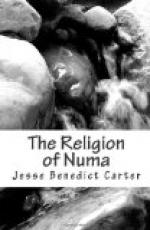in Latium or Southern Italy, and we are absolutely
certain that she was not known in Rome. In the
country north of Rome, however, the situation is different
There she is found quite frequently, especially in
Etruria under the name of MENERVA or MENRVA.
Yet she cannot have been an Etruscan goddess, because
the name itself is Italic and not Etruscan. She
is therefore neither Roman, nor Etruscan, nor Latin,
at least so far as we know Latin in Latium. If
we can find a place however where a Latin people is
under strong Etruscan influence, we shall be near
the solution. Such a place is Falerii, in the
country of the Faliscans. To the ancients it appeared
so thoroughly Etruscan that they go out of their way
to explain that it was not. As a matter of fact
it was the only Latin town on the right bank of the
Tiber, and because of its locality it was early brought
into vital connection with the Etruscans, so vital
that while it never lost all of its original Latin
character, it lost enough of it to exercise a very
considerable direct influence over Etruria, and to
be to a very large extent influenced by her in turn.
We cannot of course positively prove that Minerva
was originally worshipped only at Falerii, and that
her cult spread entirely from this one point, but we
have at least strong negative evidence, and so far
as the general history of ancient religion is concerned
there is nothing impossible in such a spread.
Religious history shows many parallels to this; for
example the classic case of the god Eros of Thespiae,
in Boeotia, who would have lived and died merely a
little insignificant local god, if it had not been
for the Boeotian poet Hesiod who adopted Eros into
his poetry and thus gave him a start in life by which
he ultimately succeeded in going all over the Greek
world, and then passing into Rome as Cupid; and so
into all later times.
We are accustomed to think of Minerva as the Latin
name for Athena, the daughter of Zeus, and unconsciously
we clothe Minerva with all the glory of Athena and
endow her with Athena’s many-sidedness.
In reality the little peasant goddess of Falerii had
originally nothing in common with Athena except the
fact that both of them were interested in handicraft
and the handicraftsman, but Athena had a hundred other
interests besides, while this one thing seems to have
filled the whole of Minerva’s horizon.
When Minerva went on her travels into Etruria, she
came among a people who eventually learned from the
representations of Greek art a very considerable amount
of Greek mythology, and who, when they heard of Athena,
saw her resemblance to Minerva and began thus to associate
the two. But even in this association Minerva
was still pre-eminently the goddess of the artisan
and the labouring man, she was the patroness of the
works of man’s hands rather than of the works
of his mind, and as such she was brought into Rome
by Etruscan and Faliscan workmen. At first she
was worshipped merely by these workmen in their own




